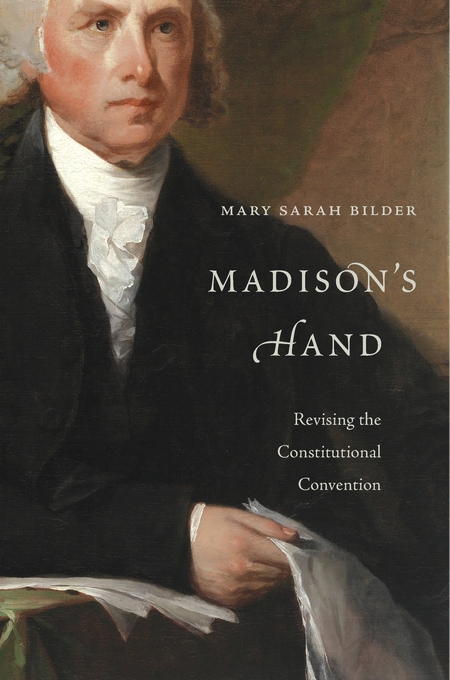
Interview with Mary Sarah Bilder, 2016 James Bradford Biography Prize Winner
 Mary Sarah Bilder is Founders Professor of Law at Boston College Law School. Her book, Madison’s Hand: Revising the Constitutional Convention, was the inaugural winner of SHEAR’s James Bradford Biography Prize.
Mary Sarah Bilder is Founders Professor of Law at Boston College Law School. Her book, Madison’s Hand: Revising the Constitutional Convention, was the inaugural winner of SHEAR’s James Bradford Biography Prize.
The Republic (TR): For those who haven’t read your book, would you provide a synopsis?
Mary Sarah Bilder (MB): Madison’s Notes of the Constitutional Convention remain the standard authority for scholars, historians, journalists, law professors—and with the rise of originalist constitutional argument–lawyers and judges. They created the narrative we inherit of the Convention. Madison’s Hand argues that the Notes do not date in their entirety to the summer of 1787, but were revised by Madison as he changed his understanding about the Convention, the Constitution, and his own role. It explores the manuscript as a text and also as a historical object, an artifact. Over fifty years, Madison transformed the Notes from an incomplete political diary, taken in part for Thomas Jefferson, to a seemingly impartial and objective account of the writing of the Constitution. In the summer of 1787, Madison only completed the Notes through August 21. In the fall of 1789, he wrote the remaining section using rough notes and a secret personal copy of the official Convention journal. He then revised the manuscript and even replaced certain of his speeches in part to accord with Jefferson’s new vision of republican politics. Madison ultimately decided not to publish the Notes in the 1790s and continued to revise them in the decades after his retirement from the presidency. Madison understood his revisions as repeated efforts to create a record—his record—of what he saw as significant in the Convention. Yet each revision—small and large—increased the distance from the summer of 1787. The story of Madison’s composition of the Notes emphasizes his inability—and that of his fellow delegates—to perceive the extraordinary document that the Constitution would become. Tracing Madison’s composition of the Notes guides us back to a moment when the substance and fate of the Constitution remained uncertain.
TR: What led you to choose this topic for your book?
MB: I had never intended to write on any of the Founders. Some years ago I thought I would try and write an article on the Framers as lawyers. In attempting to develop a list, I ran across misidentified law notes by James Madison in the Library of Congress. I wrote an article about Madison and his legal note-taking referring to him as a Demi-Lawyer, a person who never professionally identified as a lawyer. I enjoyed writing about notes and genre (I was an English major as an undergrad and my Ph.D. is from an interdisciplinary program). I thought I would write about Madison’s Convention notes the way a literary scholar might write about a text. I started by trying to find a version of the Notes that represented what they had looked like in the summer of 1787. As I became more familiar with the sources, I realized that there were significant mysteries about the manuscript. In exploring those mysteries, digital technologies allowed me to compare manuscripts at different archives and to take inexpensive watermark photographs. I was fortunate to have the significant cooperation of the Library of Congress and other archives that held Madison manuscripts.
TR: Madison’s Hand won SHEAR’s Bradford Prize for Biography, but it isn’t a traditional biography. How does your book expand historians’ definition of that genre?
MB: Unfortunately, we don’t have a good word for a book that explains how a manuscript/text developed from initial stages to iconic status—and how that also helps us understand the author’s development and the changing historical moment. As I was working on this project, I read Adam Nicolson’s God’s Secretaries: The Making of the King James Bible, which has somewhat of a similar goal. But explaining one’s project as “about the making of a manuscript” doesn’t come off as particularly methodologically sophisticated. Moreover, texts don’t make themselves and so the author is always present. I’m indebted to Jack Rakove who first suggested that the book was really a biography. The word completely captured what I was attempting to do. (At one point, I wrote a part of the introduction attempting to coin a new word to describe a biography of a text (e.g., librography, manuscriptography, scriptography)—but soon decided that biography was expansive enough to incorporate the story of a text. A biography is the story of someone’s life – and a book like mine tells that story through the lens of a particular piece of the person’s writing. It allows the historian to think about the ways in which our images of people are created through the texts they leave – which are themselves self-curated. For me, the biography label has special meaning. The first article I ever published was called “The Shrinking Back: The Law of Biography” (1992), using literary theories of biography to argue that quotations of copyrighted material used for history or biography were “facts.” It has been fun to come full circle.
TR: What is your current/next project?
MB: I was sorry not to be able to write about women in this book in any meaningful manner. My first book had a chapter on women and colonial constitutionalism. This summer, I’ve been reading around in the wonderful scholarship written over the past several decades about women and politics in the revolutionary period and early republic. I’ve been thinking about how to think about what role women played in the politics of the Convention.
